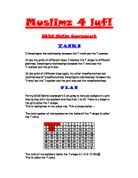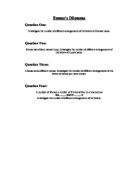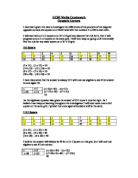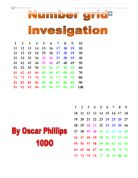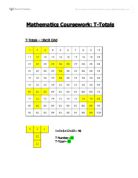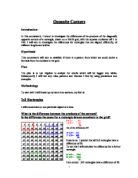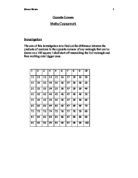Gone to Soon.
Gone to Soon I can't think, I can't speak, I'm numb inside, there is no beginning or end just this intolerable anger, and never-ending pain! I can't take this any more, if he doesn't stop; I'm going to have to hit him. There will be no question in the matter of what will happen to me, but just that one instant when nothing will matter anymore, because I will have got even. However, what he will do to me will be unimaginable! I'm 15, and have been picked on every year that I have been here at Saddlebunch Grammar School. Everyday I wake up and just imagine the unbearable torture he is going to put me through for another unliveable day. My parents don't know, there not at home long enough to see me, or the bruises he gives me. Once he had a metal bar that wrapped around his fingers, and when he punched me in the jaw, that was more than I could handle. I felt a crack, heard a large crunching sound and, black. I woke up in the nurse's office. Apparently, he had brought me in saying that I had walked into a lamppost, and he had found me unconscious on the floor. The nurse knew this was a lie, but there was nothing she could do about it. He blamed me for letting my jaw break; I was put in the bin and left in the middle of the playground with sellotape holding the lid shut. They timed it so that when everyone went to class they would leave me out there. I could be there for hours
T - ToTaLz WkD CwK- ChEk it OuT !!!!
Muslimz 4 lyf! GCSE Maths Coursework Tasks ) Investigate the relationship between the T-total and the T-number 2) Use the grids of different sizes. Translate the T-shape to different positions. Investigate relationships between the T-total and the T- number and the grid size. 3) Use grids of different sizes again, try other transformations and combinations of transformations. Investigate relationships between the T-total and the T-number and the grid size and the transformations. Plan For my GCSE Maths coursework I am going to look and analyse at a grid nine by nine with the numbers starting from 1 to 81. There is a shape in the grid called the T-shape. This is highlighted in the colour red. This is shown below: - The total number of the numbers on the inside of the T-shape is called the T-total. 2 3 4 5 6 7 8 9 0 1 2 3 4 5 6 7 8 9 20 21 22 23 24 25 26 27 28 29 30 31 32 33 34 35 36 37 38 39 40 41 42 43 44 45 46 47 48 49 50 51 52 53 54 55 56 57 58 59 60 61 62 63 64 65 66 67 68 69 70 71 72 73 74 75 76 77 78 79 80 81 The total of the numbers inside the T-shape is 1+2+3+11+20=37 This is called the T-total. The number at the bottom of the T-shape is called the T-number.
The Gradient Function.
The Gradient Function I am trying to find a formula that will work out the gradient of any line (the gradient function) I am going to start with the simplest cases, e.g. y=x² as they are probably going to be the easiest equations to solve as they are likely to be less complex and hopefully the formulas to the more complex equations will be easier to discover by looking at the previous formulas. I am going to look at the line y=x² first. y=x² X 2 3 4 y 4 9 6 One of the most obvious things I notice is that as the co-ordinates increase so does the gradient. Not only can you see that from the results below, but also on the graph you can that the line gets steeper and steeper. This makes sense as the higher the number x is the larger the difference between x² and x. Another thing that I have noticed is that the larger the co-ordinates the smaller the increase in gradient. Point Gradient (tangent) Gradient (Small Increment Method) (1,1) 2 2.01 (2,4) 3.3 3.01 (3,9) 6.36 (2dp) 6.01 (3.5,12.3) 6.4 7.001 As the table above shows there are two methods that I am using for calculating the gradient of line. The first being drawing a tangent at the point, working out the distances on the tangent using the scale on the graph and then using this formula: dy/dx However there is another way called small increment method. This method gives a more
Emma's Dilemma Question One: Investigate the number of different arrangements of the letters
Emma's Dilemma Question One: Investigate the number of different arrangements of the letters of Emma's name. Question Two: Emma has a friend named Lucy, Investigate the number of different arrangements of the letters of Lucy's name. Question Three: Choose some different names. Investigate the number of different arrangements of the letters of names you have chosen. Question Four: A number of X's and a number of Y's are written in a row such as XX.........XXYY.........Y Investigate the number of different arrangements of the letters. Question One: Investigate the number of different arrangements of the letters of EMMA's name. Answer: In order for me to answer this question, I will write down all of the different arrangements for the letters of Emma's name. This will allow me to get the total number of arrangements, which will help me to find a rule in the latter questions in this piece of coursework. Below are all of the different arrangements of the letters of Emma's name: EMMA EMAM EAMM MEMA Total: MEAM 12 MAEM MAME MMEA MMAE AMME AMEM AEMM From my results, I can see that there are 12 different combinations of the letters from Emma's name, if all of the letters are used, and only once. I have set out the letters in an ordered fashion, so that it is easier to find all of the combinations, and to only do a combination once. Therefore, my
T-Totals. We have a grid nine by nine with the numbers starting from 1 to 81. There is a shape in the grid called the t-shape.
T-Totals PART 1 We have a grid nine by nine with the numbers starting from 1 to 81. There is a shape in the grid called the t-shape. This is highlighted in the colour red. This is shown below: - 2 3 4 5 6 7 8 9 0 1 2 3 4 5 6 7 8 9 20 21 22 23 24 25 26 27 28 29 30 31 32 33 34 35 36 37 38 39 40 41 42 43 44 45 46 47 48 49 50 51 52 53 54 55 56 57 58 59 60 61 62 63 64 65 66 67 68 69 70 71 72 73 74 75 76 77 78 79 80 81 The number 20 at the bottom of the t-shape will be called the t-number. All the numbers highlighted will be called the t-total. In this section there is an investigation between the t-total and the t-number. 2 3 4 5 6 7 8 9 0 1 2 3 4 5 6 7 8 9 20 21 22 23 24 25 26 27 28 29 30 31 32 33 34 35 36 37 38 39 40 41 42 43 44 45 46 47 48 49 50 51 52 53 54 55 56 57 58 59 60 61 62 63 64 65 66 67 68 69 70 71 72 73 74 75 76 77 78 79 80 81 For this t-shape the T-number is 20 and the T-total is37 For this t-shape the T-number is 21 And the T-total is 42. As you can see from this information is that every time the t-number goes up one the t-total goes up five. Therefore the ratio between the t-number and the t-total is 1:5. This helps us because when we want to translate a t-shape to another position. Say we move
T- Total. You will notice that the centre column of the T-Shape is going up in 9s because of the table size. With the table set out like this a formula can be worked out to find any T-Total on this size grid.
T- Total 2 3 4 5 6 7 8 9 0 1 2 3 4 5 6 7 8 9 20 21 22 23 24 25 26 27 28 29 30 31 32 33 34 35 36 37 38 39 40 41 42 43 44 45 46 47 48 49 50 51 52 53 54 55 56 57 58 59 60 61 62 63 64 65 66 67 68 69 70 71 72 73 74 75 76 77 78 79 80 81 Look at the T-shape drawn on the 9 by 9 number grid. The total of the numbers inside the T-shape is 1+2+3+11+20=37 This is called the T-total. The number at the bottom of the T-shape is called theT-number. The T-number for this T-shape is 20. If you take the other numbers in the T-Shape away from the T-Number you get a T-Shape like this. T-17 T-18 T-19 T-9 T You will notice that the centre column of the T-Shape is going up in 9's because of the table size. With the table set out like this a formula can be worked out to find any T-Total on this size grid. This is done in the working below:- T-total = T-19+T-18+T-17+T-9+T = 5T-63 Now to test this formula to see if it works For T-Total I will use the letter X For the T-Number I will use the letter T So X = 5T-63 T = 20 X = 5x20-63 = 100-63 = 37 Now I will do two more to check to see if it will work anywhere on the grid. T=43 X=5x43-63 24+25+26+34+43=152 X=215-63 X=152 T=49 X=5x49-63 30+31+32+40+49=182 X=245-63 X=182 I have tested the formula for three different T-numbers and the formula
T- total T -number coursework
PART 1 I have a grid nine by nine with the numbers starting from 1 to 81. There is a shape in the grid called the t-shape. This is highlighted in the colour red. This is shown below: - 2 3 4 5 6 7 8 9 0 1 2 3 4 5 6 7 8 9 20 21 22 23 24 25 26 27 28 29 30 31 32 33 34 35 36 37 38 39 40 41 42 43 44 45 46 47 48 49 50 51 52 53 54 55 56 57 58 59 60 61 62 63 64 65 66 67 68 69 70 71 72 73 74 75 76 77 78 79 80 81 The number 20 at the bottom of the t-shape will be called the t-number. All the numbers highlighted will be called the t-total. In this section there is an investigation between the t-total and the t-number. 2 3 4 5 6 7 8 9 0 1 2 3 4 5 6 7 8 9 20 21 22 23 24 25 26 27 28 29 30 31 32 33 34 35 36 37 38 39 40 41 42 43 44 45 46 47 48 49 50 51 52 53 54 55 56 57 58 59 60 61 62 63 64 65 66 67 68 69 70 71 72 73 74 75 76 77 78 79 80 81 For this t-shape the T-number is 20 And the T-total is37 For this t-shape the T-number is 21 and the T-total is 42 As you can see from this information is that every time the t-number goes up one the t-total goes up five. Therefore the ratio between the t-number and the t-total is 1:5 This helps us because when we want to translate a t-shape to another position. Say we move it to
America's Obsession
Lauren Minchella AP English Language Mrs. Provost November 8, 2006 Barbie: America's Obsession When you picture the perfect body, what image do you get in your mind? Skinny, big-boobed, tiny waist, nice butt...Barbie. If she were to be enlarged to human size, she'd have a 39-inch bust, a 19-inch waist, and a 33-inch buttocks. She'd be over 7 feet tall and weigh an impressive 115 pounds. She's perfect! She has no body hair whatsoever, long, beautiful blonde hair, bright blue eyes, plump lips, long legs, and tiny feet. Since the 1950's, Barbie has been a symbol for females everywhere. She has become more than the doll that Ruth Handler once envisioned as a simple plaything for her daughter, Barbara (the doll's namesake.) Over the years, Barbie has had over 75 careers; she has been everything from a registered nurse to a figure skater to a rock star. Barbie from the beginning represented what the American teenager should be. The advertisements presented Barbie as a living teenager that most young girls would want to imitate. Barbie started off with a sideways glance, heavy makeup and numerous different hair colors, and eventually evolved into the blonde bombshell we all know today. Soon Ken, Barbie's "main squeeze" was introduced, later Midge, Barbie's best friend, then Skipper, Barbie's little sister. And many other different members of the Barbie family started to pop up.
ICT Coursework: Data Management Systems
Identify My mum is part of a company that sells cards. She works from home. At present, she only has hand written records, showing what she has bought from the company, and what she has sold to customers. These records are very untidy, and are always getting lost, or muddled up. She would like a better way to keep this information, and so I offered to make a spreadsheet on the computer, that would help her to do this. However, she is not very good with computers, and can only do basic things, therefore, I need to keep it as simple and easy to use as possible. The only other alternative solution to this is to continue making manual records, but to keep them in a filing cabinet. This is not such a good idea though, as it is time consuming, and takes up a lot of room. Using a computer is therefore the best way to store this information, as it saves a lot of time, and space, and keeps all records together where they can be accessed quickly and easily. Even though my mum is not very good with computers, by keeping the spreadsheet easy to use, it will be easy to teach her to use it. The result of this will mean that a lot of time is saved, and the business can run more efficiently. The advantages of using an ICT solution are that a lot of space is saved (there is no need for lots of loose paper), time is saved (all calculations are done automatically), and the business
To find out what size squares must be cut out of the corners of square and rectangle pieces of card to give the box it would create its optimum volume.
As a class we were given a mathematical problem to solve as our first bit of maths coursework for GCSE, it is called the open box problem. We have been asked to find out what size square we would have to cut out the corner of a piece of card, either square or rectangular, to find the optimum volume of that box. I will start at 1cm³ Square and work up in 1cm³. I would expect the optimum volume to most of the time be in the decimal places so I will have to look at all the decimal places between the highest volume I have and the highest one on one of its sides. During this experiment I will be looking for relationships between the length of the side and the volume of the box. Aim:- To find out what size squares must be cut out of the corners of square and rectangle pieces of card to give the box it would create its optimum volume. Prediction:- I predict that the formulas that I find for the squares will be completely different to the formulas for the rectangles. I predict that after we have found the optimum volume that the volumes after that will drop very rapidly. I also think that the size square that we have to cut out of the corner to create the box will always be quite a low number around two or three because as you cut bigger squares off the corner you lose a lot more card that could be used to make the box bigger, but when you cut a little off the corners you get



